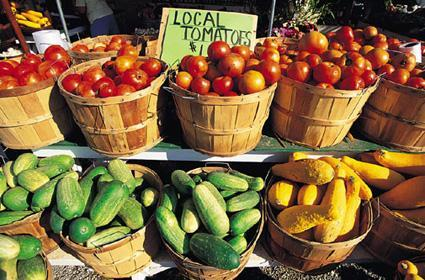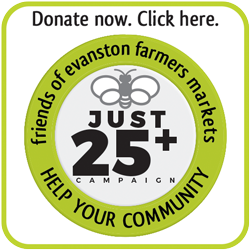While locally grown food is considered more flavorful, nutritious and ecologically friendly than what you can find at the grocery store, there is one way, in many peoples’ estimates, that it falls short: price. In recent years, the local food movement has taken hold across the country, particularly in well-to-do, environmentally conscious communities where residents can afford to pay extra for “local,” “sustainable,” or “artisanal” products. To many, local food is still seen as out of reach due to its higher price point and, as a result, the local food movement has been criticized for being elite and out of touch.
As former farmers ourselves, we know that, in order to have any chance of becoming economically viable, growers must charge a price that they feel is “fair” for both the farmer and customer – a price that is often dictated by the market. And, while that price can seem high to customers, in reality many small farms are charging less than the price that would allow them to make a living wage since they are trying to stay competitive with not only large grocery stores chains, but also each other. As a result, many small farms have made positive strides toward ecological sustainability but falter in terms of economics.
And so this brings us to one of the primary contradictions within the local food movement: the farmer’s price and products are often deflated and devalued because they are operating in a competitive food environment (even Wal-Mart has gotten in on the local food game), yet these very same prices seem high to the consumer and can be unaffordable for most “regular” people. With all of this in mind, how can we shed the belief (and perhaps the reality, depending on who you ask) that local food is a luxury and begin to address the issue of building a local food system that improves healthy food access for all people?
We can begin by critically examining the notion that local food is more expensive than food at the supermarket. The few studies to date have found the opposite – that is locally grown food is often less expensive than supermarkets (granted these studies may have limited relevance outside their specific geography). The investigators were careful to account for growing methods, i.e. not comparing organic local food to conventional supermarket produce, but consumers may not always be so discriminating.
But what gets inevitably gets lost in any discussion of price is the question of value, which is arguably much more important. Simply put, all food is not created equal. Even if that big shiny supermarket tomato is pennies cheaper per pound, chances are it was picked weeks ago when it was green and rock hard and green by an immigrant farm worker who was paid a poverty level wage, trucked across the country, ripened with ethylene gas, and is as flavorful as cardboard and probably just as nutritious. Compare that with a local tomato that you can purchase within hours of being picked ripe from the vine from a farmer who will then capture 100% of your food dollar, compared with maybe 20% at the supermarket.
Nevertheless, many families do not have the luxury of making their food choices based on quality over price. Friends has begun to tackle this issue through its matching LINK (Illinois’ food stamp) program, which makes purchasing healthy food more affordable for LINK users by providing matching funds to LINK card holders who purchase fresh produce at the downtown Evanston Farmers’ Market, effectively reducing the cost of food by half. This innovative program is aimed at addressing the economic barriers to eating locally and nutritiously, and as a result to good health.
For the many individuals and families who do not qualify for LINK but for whom healthy eating is prohibitively expensive, below are some strategies for maximizing food dollars at the farmers’ market:
- Eat Seasonally.
It may seem obvious, but there are in fact “better” and “worse” times, at least in terms of price, to purchase certain items at the market. For example, even if a farmer has lettuce in the heat of August or greenhouse tomatoes in early June, it will be far more affordable (and better tasting) to purchase those items when they are in abundance in the heart of the season – in this case tomatoes in August, and lettuce in May! - Buy in Bulk.
Farmers will often provide financial incentives for bulk purchases. This allows them to move a larger volume of food through the market during particularly bountiful weeks, and enables the consumer to purchase extra produce at a great price. Examples of items that can often be purchased in large quantities include many of the summer items, such as berries and other fruit, tomatoes, peppers, corn, zucchinis, and more. - Preserve.
If you can, we suggest freezing or preserving food purchased in bulk to be enjoyed later in the season or throughout the winter when fresh fruits and vegetables are more expensive and harder to come by. If you have the means and space, try investing in a chest freezer, since freezing is the easiest and cheapest way to preserve food and requires minimal equipment. Many veggies can be chopped and frozen fresh (i.e. tomatoes, peppers, corn, summer squash) or just frozen whole (berries). Others are better if blanched first, then frozen (green beans, greens, asparagus). Some veggies, such as potatoes, winter squash and sweet potatoes will store in a dark, dry place, or baked, mashed, then frozen in Ziploc bags. Veggies like cabbage, carrots, beets, turnips, parsnips, and other roots will store in your fridge for weeks. - Conventional vs. Organic.
Organic food is certainly more expensive than non-organic, but is it really healthier? Some research has in fact shown that organic produce may be safer, better for our health, and more flavorful than conventional produce[1], yet the health benefits of consuming a diet rich in fruits and vegetables generally outweigh the risks from eating conventional produce. Fruits and vegetables are good for us and eating more of them, as well as an increased variety of them, is one of the best steps we can take toward health and longevity. Utilizing EWG’s Dirty Dozen as a resource to help guide your organic purchases, eat organic produce as often as your budget allows but remember that eating conventional produce is much better than not eating fruits and vegetables at all.
Beyond this, moving toward a more equitable food system for both eaters and growers will require not only a massive shift in our agricultural policies, food culture, use of farmland, tastes and values, and priorities and expectations for how food is produced and its cost, but also increased attention on the problem that underlies nearly every issue our nation faces: inequality.
By Rebecca and Brian Weiland[1] Alternative Medicine Review (2010), PloS ONE (2010), J. Agriculture & Food Chemistry (2007).




